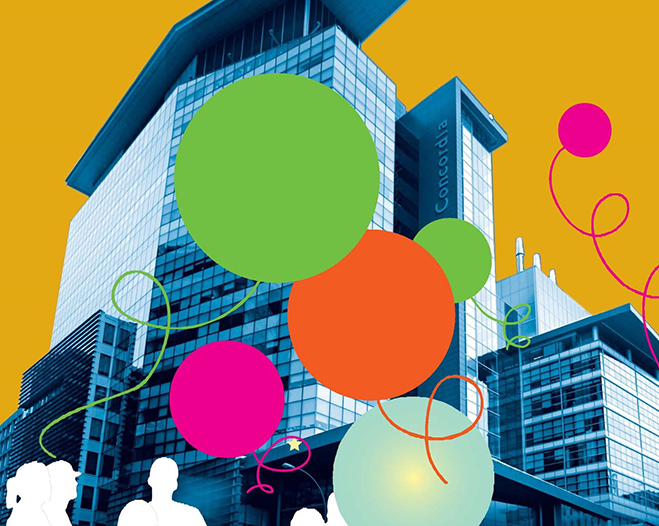A $50,000 federal boost for TeamMTL’s 2018 Solar Decathlon project
 Federal Minister Catherine McKenna with TeamMTL members Ben Wareing (McGill) and Sam Yip (Concordia).
Federal Minister Catherine McKenna with TeamMTL members Ben Wareing (McGill) and Sam Yip (Concordia).
On April 7, the Honourable Catherine McKenna, Canada’s minister of Environment and Climate Change, announced a $50,000 grant from Natural Resources Canada’s Program of Energy Research and Development (PERD) to help TeamMTL participate in the international Solar Decathlon China competition in 2018.
The grant is a huge boost to the only Canadian team competing in the event, to be held in the city of Dezhou in China's Northwestern Shandong province.
To compete, teams of university students must spend almost two years designing and building energy-efficient houses powered by the sun. During the finals, the teams and their houses compete in 10 different contest to determine the overall winner.
TeamMTL is composed of students and faculty members from Concordia University’s Faculty of Fine Arts, Faculty of Engineering and Computer Science and the John Molson School of Business, and McGill University’s School of Architecture, Faculty of Engineering and Desautels Faculty of Management.
 TeamMTL’s design is inspired by typical Montreal row houses. | Image courtesy of TeamMTL
TeamMTL’s design is inspired by typical Montreal row houses. | Image courtesy of TeamMTL
With their structure, an innovative row house called the Deep Performance Dwelling, the team prioritized energy efficiency, comfort, well-being, affordability, environmental sustainability and ecological awareness.
“Projects like this — that imagine a smart, sustainable future for our cities — speak directly to values that are integral to our mission at Concordia,” says Graham Carr, provost and vice-president of Academic Affairs.
“Integrating clean energy practices into building design, engaging with our citizens and communities, advancing social equity, and nurturing entrepreneurship and innovation are objectives we pursue,” he says.
“Many Concordia students have worked on this project, applying their technical skills, innovative thinking and marketing savvy to every step in the project.
‘It has to be inexpensive for a family’
Gary Ng, a PhD candidate in finance who manages the John Molson School of Business finance team working on the project, says that making an affordable, scalable home is one of the main objectives of the competition.
“We are trying to come up with solutions that are low-cost so it’s accessible to more families. Part of our responsibility is keeping track of the overall budget, doing the costing and a market analysis to determine what is sustainable and what is affordable in the Montreal market,” he explains.
Two universities, one project
Sherif Goubran, a PhD student in Concordia’s Individualized Program with a background in both architecture and engineering, says working on a real building is a great challenge.
“It’s fun to see the excitement around it and to see both institutions being excited together about a common project.”
Goubran has been acting as a coordinator between teams. He also lends technical expertise to the innovations that design students have added to the project.
“It’s a good opportunity to work with undergraduate students who are doing this project as an independent study or a Capstone project. You really see how it feeds into the educational mandates of the universities,” says Goubran.
 Architecture Lead Ben Wareing and Nima Nivab, Media Lead with Concordia's Topological Media Lab.
Architecture Lead Ben Wareing and Nima Nivab, Media Lead with Concordia's Topological Media Lab.
‘The level of integration is really impressive’
Nima Navab is an undergraduate student in Concordia’s Department of Design and Computation Arts. He works in Michael Montanaro’s Topological Media Lab, which is creating ambient technology for the building that will make it responsive to the needs of its inhabitants.
For students coming from new media, he says, this is interesting work.
“We are getting outside gallery spaces to work with large numbers of engineers and architects. It puts the pressure on us as artists, but it gets you thinking about a lot of issues,” he adds.
“It’s amazing sitting around with Ben, the architectural lead, Thierry and Jules from the interior team, and the engineers, banging our heads together. The level of integration is really impressive!”
Communication skills are the key to success
For Carmela Cucuzzella’s design students, working on an undertaking of this scale is intense. “The sheer size of this pedagogical project – building a net-zero house – requires cross-faculty, cross-university collaboration,” she says.
“Students learn that listening and communication skills are key to the success of the whole project. More importantly, students learn to self-organize since there are so many moving parts. These are essential skills for designers, which cannot be practiced through individual class projects.”
Find out more about Concordia’s Strategic Directions.


